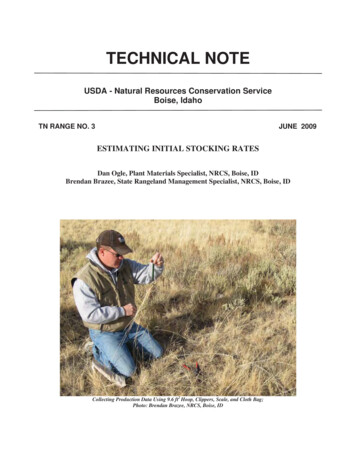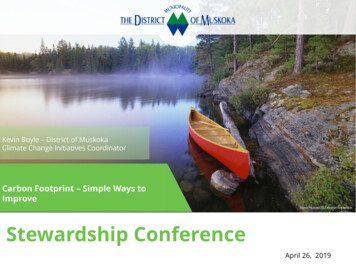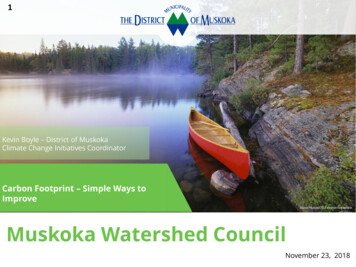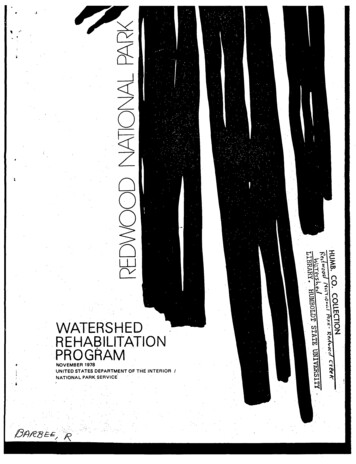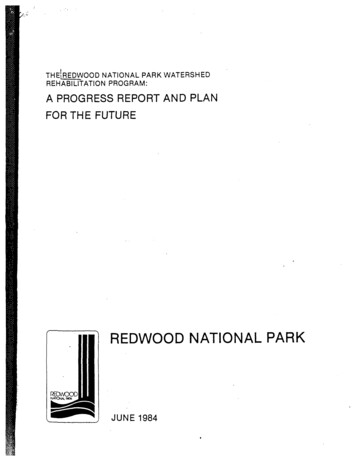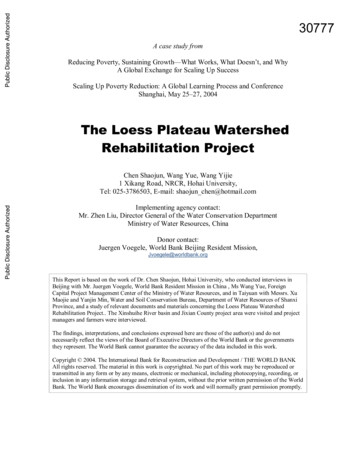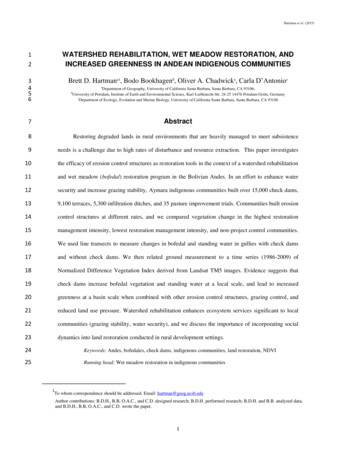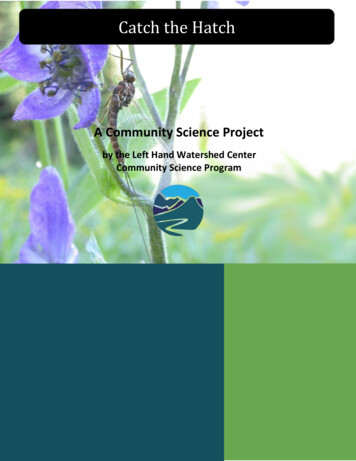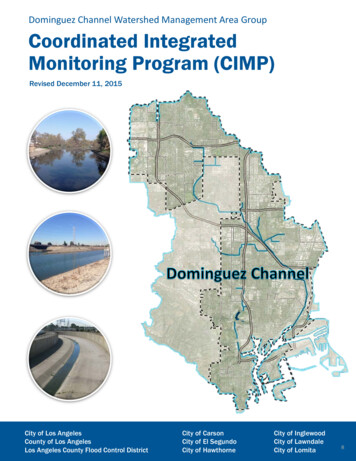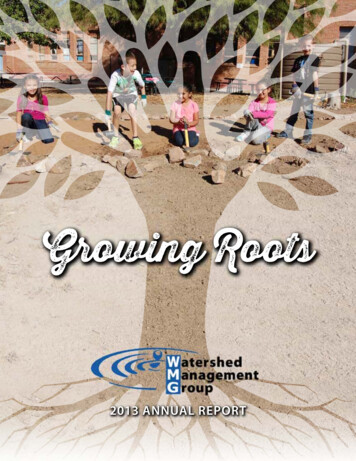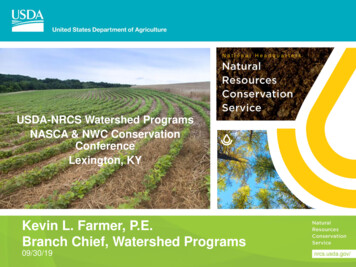
Transcription
National HeadquartersUSDA-NRCS Watershed ProgramsNASCA & NWC ConservationConferenceLexington, KYKevin L. Farmer, P.E.Branch Chief, Watershed Programs09/30/19
Watershed Programs MissionTo further watershedconservation, protection,and rehabilitation programsthrough project cooperationof federal and localgovernments across thenation
NRCS Watershed ProgramsNRCS Watershed Program Leadership NRCS Watershed Programs Overview NRCS Roles and Responsibilities Sponsor Roles and Responsibilities WFPO and Rehabilitation Program Eligibility WFPO and Rehabilitation Funding Processes Policy Revisions
NRCS Watershed Programs Overview
NRCS Watershed Programs1. Watershed & Flood Prevention Operations Program(WFPO)2. Emergency Watershed Protection Program (EWPP)3. Watershed Rehabilitation Program (REHAB)
Watershed and Flood Prevention OperationsPurposeTo provide state, local and American Indian tribalgovernments vital options to protect watersheds and vitalinfrastructure, benefiting communities in every state andterritory in the nation
Watershed and Flood Prevention OperationsOverview– Public Law 83-566, Public Law 78-534 NRCS cooperates with local Sponsors Sponsors carry out, operate, and maintain projects NRCS provides technical, financial, and credit assistanceStatistics– Over 2,000 watershed projects– Over 11,840 watershed dams– 2.2 billion in average annual benefits nationwide
Watershed and Flood Prevention OperationsProgram Benefits– Urban and Rural communities– Agricultural, Environmental, and Social benefits Flood Prevention Watershed Protection Public Recreation Fish and Wildlife Agricultural Water Management Municipal and Industrial Water Supply Water Quality Management Watershed Structure Rehabilitation
Watershed and Flood Prevention OperationsEligibility– Public Sponsorship– Watershed Projects up to 250,000 acres– Max total capacity of 25,000 acre-feet– 20% of benefits must be agriculture related– Authorized NRCS watershed plan EA/EIS– Congressional approval for federal funding over 25 millionfor construction
Watershed and Flood Prevention OperationsProgram Outline– Sponsors request NRCS assistance to:1. Request plan authorization2. Carryout existing authorized plan3. Prepare NRCS watershed Plan-EA/EIS– NRCS assists sponsor with project feasibility report andpreliminary investigation– Project sponsors carry out and fund specific parts of theWatershed Plan– NRCS provides financial and technical assistance Planning, Design, Construction
Watershed and Flood Prevention OperationsFiscal Year 2017– 150 million in NRCS funds Planning Design Construction– 20 states with 48 projects– First Funding in 7 years
Watershed and Flood Prevention OperationsFiscal Year 2018– 150 million in NRCS funds Planning Design Construction– 16 states with 47 projects
Watershed and Flood Prevention OperationsFiscal Year 2019– 150 million in discretionary funds Planning Design Construction– 50 million in mandatory funding (Farm Bill)– 21 states with 76 proposals requesting 280M
Watershed and Flood Prevention OperationsCost ShareFederal Cost Share by PurposePurposeFlood PreventionWatershed g Construction100%100%100%Varies100%Up to 50%Agricultural WaterManagementM&I Water SupplyWater Quality ManagementUp to 100%0%Up to 100%Up to 75%Up to 50%VariesRehabilitationUp to 100%Up to 100%
Watershed and Flood Prevention OperationsFiscal YearProgram RA) 20092010201720182019TotalIncludes 50M of Mandatory funding in the Farmbill 99 M 99 M 106 M 109 M 86 M 74 M 75 M 0 M 29 M 24 M 145 M 30 M 150 M 150M 200 M* 1,376 M
Emergency Watershed Protection ProgramPurposeTo provide emergency repair and restoration recoveryassistance when sudden watershed impairments occur thatcreates an imminent threat to life or property
Emergency Watershed Protection ProgramOverview– Provide local communities assistance to recover from naturaldisasters such as: FloodsFireDroughtWindstormsEarthquakes– Must reduce threats to life or property– Must be economically, environmentally, and socially defensible– Exigency vs Emergency– Recovery and Flood Plain easements
Emergency Watershed Protection ProgramEligibility– Private entities may only receive EWP recovery assistancethrough an eligible project sponsor such as: State GovernmentsCitiesTownsCounties/ParishesMunicipal AuthoritiesNative American Tribes and Tribal organizations– Eligible Lands Private land Non-Federal public land Federal lands on Non-Federal right-of-way
Emergency Watershed Protection ProgramSponsor Responsibilities– Participate on damage survey assessment teams– Secure land rights for repair work– Obtaining all permits– Local cost share– Administer local contracts– Necessary operations and maintenance
Emergency Watershed Protection ProgramProgram Outline– Natural Disaster occurs– NRCS conducts a rapid survey damage assessment– Sponsor submits written application for assistance to StateConservationist– Determine exigencies vs emergencies– Damage Survey Report (DSR) Completed/Approved– NRCS provides financial and technical assistance
Emergency Watershed Protection ProgramFunding– Standard Cost Share (75/25)– Limited Resource Cost Share(90/10) Housing values 75% stateaverage Per capita income 75% ofstate average Unemployment twice theUS averageEWPP Fundingby YearFiscal YearProgramFunding2006 306 M2007 10 M2008 490 M2009-2011 0 M2012 216 M2013 235 M2014 0 M2015 79 M2016 157 M2017 103 M2018 541 M2019 217.5 MTotal 2,354.5 M
Emergency Watershed Protection ProgramDebris RemovalBeforeAfter
Emergency Watershed Protection ProgramGrade StabilizationBeforeAfter
Emergency Watershed Protection ProgramStreambank StabilizationBeforeAfter
Emergency Watershed Protection ProgramFire RecoveryBeforeAfter
Watershed Rehabilitation ProgramPurposeProvides technical and financial assistance to rehabilitate andextend service life of dams originally constructed withassistance of NRCS Watershed Programs
Watershed Rehabilitation ProgramOverview– Authorized by Public law 83-566– 11,840 dams in 1,271 watersheds since 1948– Aging NRCS dams nearing end of service life Watershed developmentLand use changesSediment AccumulationStructural Deterioration
Watershed Rehabilitation ProgramProgram Benefits– 47 million people protected– Dam Rehabilitation Purposes Water SupplySediment and Erosion controlPublic SafetyFlood ProtectionRecreationWildlife Habitat
Watershed Rehabilitation ProgramEligibility– Originally constructed through a NRCS WatershedProgram PL 83-566PL 78-534Pilot Watershed ProgramResource Conservation and Development (RC&D)– Priority given to high risk dams– NRCS provides assessment, planning, design, andimplementation assistance 65% total rehabilitation cost Not to exceed 100% construction costs
Watershed Rehabilitation ProgramProgram Outline– Local Sponsor requests NRCS assistance– Dam assessment– Planning Phase– Design Phase– Construction Phase
Watershed Rehabilitation ProgramRehab Funding HistoryFiscal 1120122013201420152016201720182019TotalProgram Funding 8 M 8 M 10 M 30 M 30 M 28 M 32 M 31 M 20 M 35 M 83 M 17 M 15 M 14 M 262 M 83 M 12 M 21 M 12 M 10 M 761 M
NRCS Roles and Responsibilities
NRCS ResponsibilitiesNRCS State ResponsibilitiesThe State Conservationist (STC) is responsible for the overallmanagement of the Watershed Program in his or her Stateand is to provide for the coordination, organization, andmanagement of program activities to ensure that all phases ofthe program are carried out effectively and efficiently.
NRCS ResponsibilitiesNRCS State Responsibilities(i) Adherence to State and Federal Requirements– The STC of the State in which the watershed or major portion thereofis located will provide overall guidance and ensure that the watershedproject plan adheres to all statutory, regulatory and policyrequirements of the State.– Plans on Federal Lands.—Project measures planned for installationon Federal lands must conform to the standards and specifications ofNRCS, as well as those of land-administering agencies involved.Where differences in standards exist, conform to the higheststandard.– Fish and Wildlife Service Notification.—The STC must notify the U.S.Fish and Wildlife Service (USFWS) in order that it may providerecommendations for fish and wildlife resources, in accordance withthe provisions of Public Law 83-566 Section 12.
NRCS ResponsibilitiesNRCS State Responsibilities(ii) Watershed Program Information Assistance– NRCS will provide information to interested parties on the potential for andtype of assistance available through the Watershed Program.– NRCS will also provide guidance in making preliminary investigations todetermine if assistance is warranted and help in preparing the necessaryapplications.(iii) Preparation of the Watershed Project Plan– NRCS will assist the sponsoring local organization (SLO) in preparing awatershed project Plan environmental assessment (Plan-EA) orenvironmental impact statement (Plan-EIS) with the cooperation andassistance of State, local, and other Federal agencies. NRCS isresponsible for the content and quality of the Plan-EIS, Plan-EA, or PlanEE for the purposes of National Environmental Policy Act (NEPA)compliance.– NRCS and the SLO will each bear responsibility for funding their owncosts incurred for watershed project planning and public participation.
NRCS ResponsibilitiesNRCS State Responsibilities(iv) Implementation Assistance–NRCS will provide technical assistance, financial assistance, or both to installmeasures for projects that include approved Watershed Program implementationassistance.(v) Real Property Rights Work Maps–Real property rights work maps will be provided by NRCS to the SLO. Further landrights responsibilities are provided in this manual in Title 390, National WatershedProgram Manual (NWPM), Part 504, Subpart A, Section 504.3.(vi) Operation and Maintenance Assistance–NRCS will provide technical assistance to the SLO in the operation and maintenance(O&M) of projects and replacement of installed measures as defined in the O&Magreement.(vii) Soil and Water Conservation District or Natural Resource District Involvement–NRCS will encourage the SLO to invite each soil and water conservation district(SWCD) and natural resource district (NRD) in the project area to participate inwatershed project activities as an official project sponsor.
NRCS ResponsibilitiesNRCS National Headquarters Responsibilities–The Deputy Chief is responsible for coordinating the development of national policy,standards, and procedures for project planning, installation, operation andmaintenance, and allocation of program funds.–The Division director provides staff leadership to support this and confers with theother divisions, as well as with appropriate Federal agencies and congressionalcommittees to deliver the program.–The Watershed Surveys and Planning Program national program manager will reviewall Watershed Program plans for programmatic compliance. This programmaticreview is conducted after the National Water Management Center review and beforethe final plan is sent to the Chief.–The Watershed Operations Program national program manager will review allwatershed project plan modifications, including revisions and supplements forprogrammatic compliance.–The Watershed Rehabilitation Program national program manager will review allwatershed rehabilitation plans for programmatic compliance.–By exchange of correspondence, the Chief approves watershed project plans forfunding authorization, subject to appropriations, after all reviews and comments areaddressed.
Sponsor Roles and Responsibilities
Sponsor ResponsibilitiesSponsor ResponsibilitiesWatershed projects are sponsored by one or more local organizations.The STC must require that at least one SLO of each project provide forthe functions listed below:(1) Power of Eminent Domain.—At least one SLO must have the powerof eminent domain so that it may acquire real property, water, mineral,and other rights needed for the project (Public Law 83-566 Section 4(4)).This is not required for projects where all works of improvement are to beinstalled by land treatment long-term contracts.(2) Permits and Licenses.—The SLO must acquire needed permits,and licenses in accordance with local, State, and Federal laws.(3) Authority to Levy Taxes.—At least one SLO must have andexercise the authority to levy taxes or provide another adequate meansof financing the local share of the cost of the project as well as operationand maintenance expenses.
Sponsor ResponsibilitiesSponsor Responsibilities(4) Land Treatment above Reservoirs.—The SLO must obtainagreements from landowners to implement soil conservation plans thatmeet NRCS Field Office Technical Guide (FOTG) criteria on not lessthan 50 percent of the lands situated in the drainage area above eachretention reservoir to be installed with Watershed Program funds (PublicLaw 83-566 Section 4(5)). Projects that include land treatment practicesmust, at a minimum, have an SLO that has soil and water conservationresponsibilities organized under State law.(5) Public Participation.—The SLO must arrange for and carry outactivities that encourage the public to participate in the watershed projectplanning process.(6) Financial.—The SLO must show evidence of commitment forfunding, installing, operating, and maintaining the project. The SLO willperform all contracting for construction of any structure, except thatNRCS may perform contracting upon request.
Sponsor ResponsibilitiesSponsor Responsibilities(7) Watershed Management.—The SLO must implementneeded watershed management features such as permitting,zoning, land use regulations, easements, or upstreamwatershed protection.(8) Municipal and Industrial (M&I) Water.—The SLO mustprovide evidence that any proposed municipal and industrialwater supply use will be acceptable in quantity and quality tomeet the anticipated needs. The SLO must provide alltechnical services to implement M&I water supply. The SLOmust provide adequate assurances prior to initiation ofconstruction that USDA will be reimbursed for at least one-halfof the cost of M&I storage for current demand and all of thecost of M&I storage for future demand.
Sponsor ResponsibilitiesSponsor Responsibilities(9) Operation and Maintenance.—The SLO must use itspowers and authority to ensure the installation, operation, andmaintenance of the project as planned (Public Law 83-566Section 4(3)).(10) Storm and Sanitary Sewers.—New storm and sanitarysewers, or relocations and changes to existing sewerfacilities, in urban or built-up areas are the sole responsibilityof the SLO.
Sponsor ResponsibilitiesSponsor ResponsibilitiesSponsoring Local Organization Request Planning AssistanceIt is the responsibility of the SLO to request NRCS planningassistance and authorization to develop either a watershedproject plan under Public Law 83-566 or a subwatershed planunder Public Law 78-534, including an environmentalassessment (EA) or an environmental impact statement (EIS).The following items are needed to support a request forplanning authorization:(i) Preliminary investigation report, indicating project feasibility(ii) Valid application – Standard Form (SF) 424
WFPO and Rehabilitation Program Eligibility
WFPO and Rehabilitation Program EligibilityWFPO Program Eligibility– No project will be funded for planning or implementationunder the Public Law 83-566 or Public Law 78-534authority unless it meets all requirements set fourth in theNational Watershed Program manual.– The undertaking must be for the benefit of the generalpublic– Must comply with applicable federal, State and local laws,regulations and Executive orders
WFPO and Rehabilitation Program EligibilityWFPO Program Eligibility– All watershed plans shall be sponsored by entities legallyorganized under State law or by any Indian tribe or tribalorganization having the authority to carry out, operate andmaintain works of improvement.
WFPO and Rehabilitation Program EligibilityWFPO Program Eligibility– The Watershed Program requires the development ofphysically, environmentally, socially, and economicallysound watershed project plans with actions scheduled forimplementation over a specified period of years.– Project sponsors must have the legal authority andresources to carry out, operate, and maintain works ofimprovement
WFPO and Rehabilitation Program EligibilityWFPO Program Eligibility– Three general purposes:– (i) Preventing damage from erosion, floodwater, andsediment– (ii) Furthering the conservation, development, utilization,and disposal of water– (iii) Furthering the conservation and proper utilization ofland
WFPO and Rehabilitation Program EligibilityWFPO Program EligibilityAuthorized project purposes(i) Flood Prevention (Flood Damage Reduction)– Flood prevention or flood damage reduction measures areinstalled to prevent or reduce damages caused by floodwater.Flood damage reduction is further defined as the control anddisposal of surface water caused by abnormally high directprecipitation, stream overflow, or floods aggravated or causedby wind or tidal effects. Flood damage reduction andmitigation measures reduce or prevent floodwater damages byreducing runoff, erosion, and sediment; modifying thesusceptibility of improvements in the floodplain to damage;removing damageable property from the floodplain; orreducing the frequency, depth, or velocity of flooding.Measures may also include actions that preventencroachment into the floodplain.
WFPO and Rehabilitation Program EligibilityWFPO Program EligibilityAuthorized project purposes.(ii) Watershed Protection–Watershed protection consists of onsite treatment of watershed natural resources concernsfor the primary purpose of reducing offsite floodwater, erosion, sediment, and agriculturerelated pollutants. Watershed protection plans may include ecosystem restoration typeactivities. Any practice or combination of practices listed in Title 450, National Handbook ofConservation Practices (NHCP), may be considered for inclusion in the systems ofpractices included in a watershed protection project plan. Project measures for watershedprotection include land treatment practices installed by land users to conserve and developany of the following:–Soil–Water quality and quantity–Woodland–Fish and wildlife habitats–Energy–Recreation and scenic resources
WFPO and Rehabilitation Program EligibilityWFPO Program EligibilityAuthorized project purposes.(ii) Watershed Protection– Public Law 83-566 requires that the SLO must “obtainagreements to carry out recommended soil conservationmeasures and proper farm (conservation) plans from ownersof not less than 50 percent of the lands situated in thedrainage area above each retention reservoir to be installedwith Federal assistance.” USDA policy requires installation ofland treatment practices necessary to ensure that at least 50percent of the land upstream from any retention reservoir isadequately protected before beginning construction of theretention reservoir.
WFPO and Rehabilitation Program EligibilityWFPO Program EligibilityAuthorized project purposes.(iii) Public Recreation– Public recreation developments may be included in a watershed projectplan when the SLO agrees to operate and maintain a reservoir or otherarea for public recreation. Project measures must include only minimumbasic facilities needed for public health and safety and access to, and useof the area. Minimum basic facilities may include picnic areas, sanitaryfacilities, fishing piers, shelters, cooking grills, parking areas, swimmingbeaches, access roads, water, and trails. Also includ
– The Watershed Rehabilitation Program national program manager will review all watershed rehabilitation plans for programmatic compliance. – By exchange of correspondence, the Chief approves watershed project plans for funding authorization, subject to appropriations, after all reviews and comments are .

